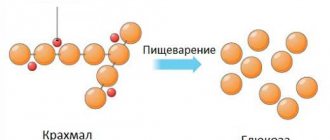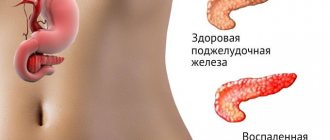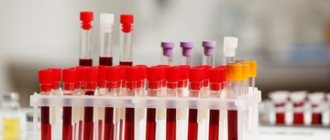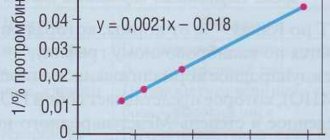The enzyme alpha-amylase is an organic protein substance synthesized in the human body. The main producers of the enzyme are the mixed secretion pancreas and the exocrine (exocrine) salivary glands. The enzyme is detected in minute amounts in the liver, lungs, kidneys, intestines, and uterine appendages in women.
During examination, the substance is found in biological fluids (urine and blood). Its concentration must comply with accepted standards for laboratory microscopy. Alpha-amylase in the blood is reduced most often in liver pathologies and tumor processes. An elevated level of the enzyme indicates the development of pancreatic pathologies.
Reference! Alpha-amylase is found in animals and humans; β-amylase and γ-amylase are active in plants.
Total α-amylase in the blood is divided into pancreatic diastase (P-type) and salivary amylase (S-type), in a percentage ratio of 40% to 60%. The main purpose of amylase is the breakdown of complex carbohydrates (glycogen and starch) into their constituent monosaccharides and their residues.
In laboratory diagnostics of urine, diastase (pancreatic α-amylase filtered in the renal apparatus) and the concentration of alpha enzyme in the blood are assessed. A urine test is considered more informative, since filtration and excretion of the substance is carried out by the renal apparatus. A small amount of pancreatic enzyme enters the systemic circulation.
Normal blood amylase levels
By gender, alpha-amylase standards are practically the same. A slight difference in indicators is allowed in women during the perinatal period. This is due to changes in hormonal status, body weight, gastronomic preferences, which affects the qualitative and quantitative content of biologically active substances in the body. Amylase concentrations in pregnant women are assessed as part of routine screenings.
If there are significant discrepancies between the results in relation to the reference values, the pregnant woman is indicated for hospitalization with additional examination. Women in the premenopausal period and during menopause are recommended to monitor amylase levels in the blood and urine annually. The reason is hormonal changes in the female body.
According to the age criterion, the level of pancreatic enzyme increases as the child grows older. Stable indicators are recorded in adults from 18 to 70 years. In people 70+, an increase in values is associated with age-related changes in the body, and is not considered a pathology.
The measurement value for alpha-amylase in a biochemical blood test is U/L (units per liter). Some laboratories measure using the International System of Units (SI). To convert units/l to the SI system, the result must be multiplied by a factor of 0.688.
Table of normative indicators of total amylase
| Infants up to one year old | Children from one to 10 years old | Children and adolescents up to adulthood | Adults about 18 to 40 years old | Elderly people (70+) |
| up to 8 units/l | up to 30 units/l | from 25 to 40 units/l | from 25 to 125 units/l | up to 160 units/l |
Deviations in the analysis results, upward or downward, by more than 30 units in adults, and by 10 units in children, indicate the development of inflammatory processes, acute conditions and chronic diseases. If a high level of pancreatic enzyme is a clinical sign of pathology, then low amylase in the blood does not indicate a specific disease.
In this case, the analysis must be carried out several times. If alpha enzyme levels are consistently reduced, the patient is prescribed additional laboratory tests and hardware diagnostic procedures.
Normal amylase content in urine
Amylase, which is detected in urine, is called diastase. Its activity is several times higher than blood amylase. This can be explained by the fact that amylase is in a more dilute state in the blood. Passing through the kidneys, it is concentrated in a small volume of urine. Therefore, its definition is used more often. Moreover, for analysis you only need to collect urine. The only thing you need to remember is the possibility of increased diastasis not only in connection with pancreatic pathology.
The established laboratory standards for diastase are as follows:
- In U/l – up to 1000;
- In µkatal/l – 28-100.
Reasons for low performance
Low amylase levels are not abnormal in young children. Due to the characteristics of the baby’s diet and digestive system, a small amount of pancreatic enzyme is sufficient. The main part of amylase is found in the baby's salivary glands, helping him to fully absorb breast milk.
The activity of amylase and other digestive enzymes may be reduced in children due to the severe congenital pathology of muscovidesis. The disease is characterized by dysfunction of the exocrine glands and the functioning of the digestive and respiratory organs. The cause of the disease is the inheritance of damaged genes from both parents (autosomal recessive inheritance). Infants in the first year of life with this diagnosis have an extremely unfavorable prognosis.
A pathological abnormality associated with enzyme deficiency is fermentopathy. The disease may be congenital or acquired. In the first case, the decisive factor in the occurrence of digestive abnormalities is a genetic cause. In the second, stable eating disorders or chronic pathologies of the gastrointestinal tract (gastrointestinal tract).
What is lipase in a biochemical blood test?
Other reasons for decreased alpha-amylase concentrations are associated with diseases of the hepatobiliary system:
- Irreversible transformation of hepatocytes (liver cells) into connective tissue – cirrhosis. By nature of origin it can be viral, alcoholic, metabolic and nutritional.
- Chronic inflammatory liver damage - hepatitis. The chronic form develops as a result of incorrect therapy or patient violation of the rules for treating viral hepatitis A, B, C.
Deviations in the analysis parameters are observed in case of mechanical damage (tissue rupture, blood vessels, bruises, wounds, etc.) of the digestive system. The level of alpha-amylase in this case can be either lower than normal or higher. Reduced enzyme activity is recorded in the postoperative period in patients who have undergone surgery on the abdominal organs.
The most common reason is partial resection or complete removal of the pancreas (pancreatectomy). Another cause of enzyme deficiency is extreme pancreatitis, characterized by the death of pancreatic cells - pancreatic necrosis. The degeneration of cells and tissues of the body, with the loss of the ability to produce biologically active substances, accompanies cancer. In severe stages of cancer, the synthesis of enzymes, hormones, etc. decreases or completely stops.
The only treatment for pancreatic necrosis is pancreatic necrectomy
A rare pathology in which the concentration of amylase is disrupted is benign macroamylasemia (an abnormal combination of enzyme molecules with other blood molecules). A low level of α-amylase in the blood of women during pregnancy characterizes toxicosis of pregnant women.
With insufficient production of alpha-amylase, overactivity of the thyroid gland often occurs - hyperthyroidism or excess production of hormones. Regardless of the reason, a lack of an enzyme inhibits the full functioning of the digestive organs. The body is not able to properly process and absorb nutrients (fats, proteins, carbohydrates). Metabolism is disrupted, diseases of the gastrointestinal tract and endocrine system progress.
Amylase
Amylase is one of the enzymes of digestive juice, which is secreted by the salivary glands and pancreas.
Research method
Kinetic colorimetric method.
Units
U/L (unit per liter).
What biomaterial can be used for research?
Venous blood.
How to properly prepare for research?
- Do not eat for 12 hours before the test.
- Avoid physical and emotional stress and do not smoke 30 minutes before donating blood.
General information about the study
Amylase is one of several enzymes that are produced in the pancreas and are part of pancreatic juice. Amylase breaks down carbohydrates. From the pancreas, pancreatic juice containing amylase passes through the pancreatic duct into the duodenum, where it helps digest food.
Normally, only a small amount of amylase circulates in the bloodstream and ends up in the urine. If the pancreas is damaged, as in pancreatitis, or if the pancreatic duct is blocked by a stone or tumor, amylase begins to leak into the bloodstream in large quantities and then into the urine.
Small amounts of amylase are produced in the ovaries, intestines, bronchi and skeletal muscles.
What is the research used for?
- To diagnose acute or chronic pancreatitis and other diseases involving the pancreas in the pathological process (together with a lipase test).
- To monitor treatment for cancer affecting the pancreas.
- To ensure that the pancreatic duct is not compromised after removal of gallstones.
What do the results mean?
Reference values: 28 - 100 U/l.
Reasons for increased activity of total amylase in serum
- Acute pancreatitis. With this disease, amylase activity can exceed the permissible level by 6-10 times.
- Chronic pancreatitis.
- Trauma to the pancreas.
- Pancreas cancer.
- Blockage (stone, scar) of the pancreatic duct.
- Acute appendicitis, peritonitis.
- Perforation (perforation) of a stomach ulcer.
- Decompensation of diabetes mellitus – diabetic ketoacidosis.
- Impaired flow in the salivary glands or salivary ducts, for example with mumps (mumps).
- Operations on the abdominal organs.
- Acute cholecystitis is inflammation of the gallbladder.
- Intestinal obstruction.
- Aborted tubal pregnancy.
- Ruptured aortic aneurysm.
Reasons for decreased activity of total amylase in serum
- Decreased pancreatic function.
- Severe hepatitis.
- Cystic fibrosis.
- Removal of the pancreas.
What can influence the result?
- Serum amylase activity increases: in pregnant women,
- when taking captopril, corticosteroids, oral contraceptives, furosemide, ibuprofen, narcotic analgesics.
Important Notes
- In acute pancreatitis, an increase in amylase is usually accompanied by an increase in lipase activity.
- Amylase activity in children is low in the first two months of life; it rises to adult levels by the end of the first year.
When is laboratory diagnostics necessary?
α-amylase is included in the list of indicators to be assessed as part of a biochemical blood test. This is a method of laboratory research of the physical properties and chemical composition of blood, which allows one to assess the functionality of internal organs and identify possible disorders.
The analysis is prescribed:
- for symptomatic patient complaints;
- for prevention purposes;
- to control the therapy.
The main direction of research into the digestive enzyme (pancreatic amylase) is the timely diagnosis and control of treatment of pancreatic diseases. Emergency diagnostics of alpha-amylase levels is carried out if:
- for acute inflammation of the pancreas (acute pancreatitis);
- inflammation of the serous covering of the peritoneum (peritonitis);
- ectopic pregnancy.
Important! With a high level of α-amylase in the blood against the background of acute pain in the left abdomen, radiating to the left clavicle and lower back, nausea and vomiting, accompanied by low-grade body temperature (37–38 °C), acute pancreatitis is 100% diagnosed.
Regular blood microscopy to determine the level of alpha-amylase is necessary for diabetics, patients with chronic pathologies of the pancreas and liver, and cancer patients. The blood sampling procedure is carried out in a laboratory, in the morning, and strictly on an empty stomach. To obtain objective final data, the patient is recommended to:
- three days before the analysis, eliminate fatty foods, hot seasonings and spices, and alcoholic beverages from the diet;
- stop taking medications (diuretics, enzymatic, hormone-containing, non-steroidal anti-inflammatory drugs);
- On the eve of the procedure, limit sports and other physical activities.
The duration of fasting before the study is 8–12 hours.
What is amylase?
Amylases (alpha-amylase) are a group of enzymes that serve to break down complex carbohydrates inside the pancreas, which is an exocrine gland.
The enzyme is synthesized by acinar cells and then passes through the pancreatic ducts to reach the digestive tract. Amylases are also produced by the salivary glands, small intestinal mucosa, ovaries, placenta and liver. Pancreatic and salivary isoenzymes are detected in the blood at high concentrations by examination.
Under normal conditions, amylase is present in small amounts in the blood and urine, however, when the cells of the pancreas have some problem, such as pancreatitis or when the pancreas is blocked by a stone, or in rare cases by a tumor, the enzymes enter the blood circulation more easily, so their concentration increases as in blood and in urine (amylase leaves the body through urine).
Amylase testing is often used by doctors to diagnose pancreatitis. Pancreatic amylase testing (amylase P isoenzyme) is most useful for laboratory diagnosis of acute pancreatitis.
Total serum (blood) is still the most widely used method for diagnosing acute pancreatitis and is accurate to 95% (accuracy of a diagnostic test refers to its ability to provide true values).
Additionally
Elevated enzyme values in the results of biochemical examination are determined much more often than low values. A high concentration of α-amylase indicates possible diseases:
- pancreatitis and pancreatic cancer;
- intestinal obstruction;
- diabetes mellitus and diabetic ketoacidosis;
- peptic ulcer of the duodenum and stomach;
- ectopic pregnancy;
- cholelithiasis and urolithiasis;
- CRF, chronic renal failure;
- alcoholism;
- parasitic infestations;
- mumps (mumps);
- appendicitis.
If the test results deviate from the norm, the patient requires additional examination.
Decoding the results
Competent interpretation of the study results can only be performed by a doctor; self-medication is unacceptable. Normally, the enzyme concentration should not exceed 53 U/l. If the indicators deviate from the norm, the doctor prescribes an additional examination in order to make an accurate diagnosis and choose the most effective treatment method.
Important Notes:
- determination of the enzyme level is not included in the CBC;
- while taking a number of medications, it is possible to obtain false results;
- the test result is influenced by high cholesterol levels;
- In patients with chronic renal failure, false-positive results may be obtained.
Causes of increased and decreased alpha-amylase
An increase in indicators may be caused by the following reasons:
- pancreatic injury;
- inflammatory process;
- malignant degeneration of the pancreas;
- peritonitis;
- perforated ulcer;
- intestinal obstruction;
- pancreatitis;
- appendicitis;
- aneurysm rupture.
To determine the exact cause of the increase in the amount of enzyme and prescribe treatment (if necessary), additional examination is carried out. A decrease in indicators can be observed with cystic fibrosis.
When interpreting the results, not only the level of pancreatic amylase is taken into account, but also the total amount of enzyme. If general indicators are increased and pancreatic enzyme activity is decreased, this indicates that pancreatic pathologies are most likely absent. In such cases, an examination is carried out aimed at establishing an accurate diagnosis.
The most common cause of increased levels is pancreatitis.
Usually, enzyme activity increases significantly, but in some cases it may remain within normal limits. It must be taken into account that the results of this test cannot determine the degree of damage to the pancreas. When the disease becomes chronic, the indicators first increase and then can gradually decrease as the pathological process progresses.
Results
Alpha amylase is an essential digestive enzyme synthesized by the pancreas and salivary glands. The concentration of the substance in the body is determined through a biochemical analysis of blood and urine. If the values decrease below the reference values, the doctor may suspect the development of liver pathologies and hyperthyroidism. In children, the cause of the disorder is genetic pathologies of enzyme production (muscovidosis, enzymopathy).
The lower limit of normal for adult men and women of reproductive age is considered to be 25 units/l. (top – 125 units/l). In children, normative indicators depend on age. If the indicators change in one direction or another, it is necessary to undergo additional diagnostics, including laboratory tests and hardware procedures (ultrasound, MRI, CT, etc.).
Why is amylase low in the blood?
In general, if blood amylase tends to zero, this is a normal condition, which indicates the ability of the pancreas to keep this enzyme under control. But in practice this does not happen. In each person, the study of amylase will reveal a certain amount of it in the plasma. If the resulting value is much less than the lower limit of normal, this indicates that the enzymatic activity of the pancreas is sharply reduced.
This can happen with diseases:
- Total pancreatic necrosis (complete self-digestion of the pancreas);
- Stage 4 malignant tumors of the pancreas, when the normal glandular tissue of the organ is replaced by tumor tissue;
- Cystic fibrosis is a fermentopathy of congenital origin;
- Surgeries on the pancreas, in which most of the organ is removed.









